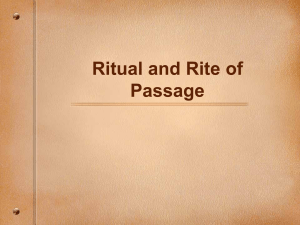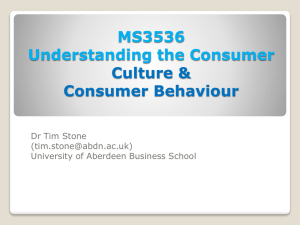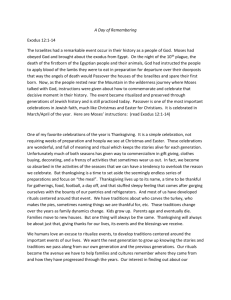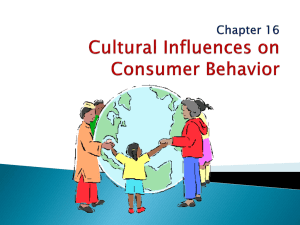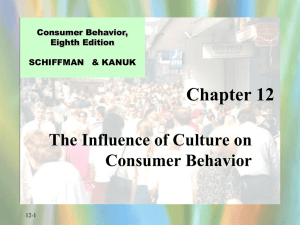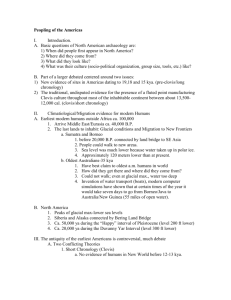Rituals and Social Bonding - Southeastern Louisiana University
advertisement
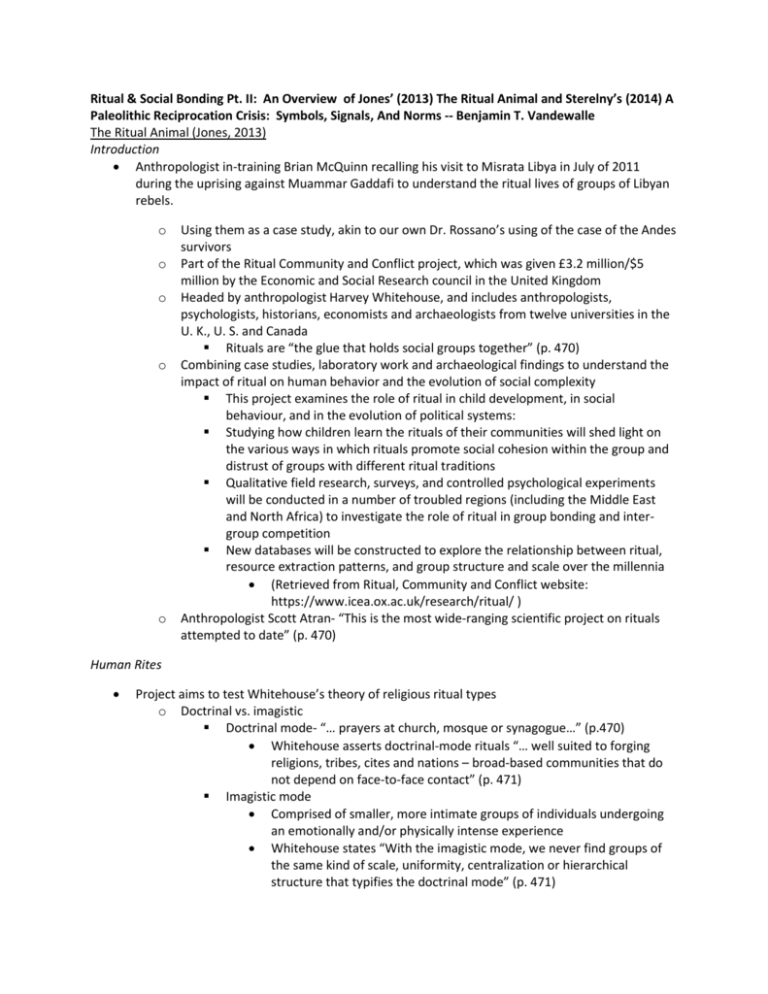
Ritual & Social Bonding Pt. II: An Overview of Jones’ (2013) The Ritual Animal and Sterelny’s (2014) A Paleolithic Reciprocation Crisis: Symbols, Signals, And Norms -- Benjamin T. Vandewalle The Ritual Animal (Jones, 2013) Introduction Anthropologist in-training Brian McQuinn recalling his visit to Misrata Libya in July of 2011 during the uprising against Muammar Gaddafi to understand the ritual lives of groups of Libyan rebels. o o o o o Using them as a case study, akin to our own Dr. Rossano’s using of the case of the Andes survivors Part of the Ritual Community and Conflict project, which was given £3.2 million/$5 million by the Economic and Social Research council in the United Kingdom Headed by anthropologist Harvey Whitehouse, and includes anthropologists, psychologists, historians, economists and archaeologists from twelve universities in the U. K., U. S. and Canada Rituals are “the glue that holds social groups together” (p. 470) Combining case studies, laboratory work and archaeological findings to understand the impact of ritual on human behavior and the evolution of social complexity This project examines the role of ritual in child development, in social behaviour, and in the evolution of political systems: Studying how children learn the rituals of their communities will shed light on the various ways in which rituals promote social cohesion within the group and distrust of groups with different ritual traditions Qualitative field research, surveys, and controlled psychological experiments will be conducted in a number of troubled regions (including the Middle East and North Africa) to investigate the role of ritual in group bonding and intergroup competition New databases will be constructed to explore the relationship between ritual, resource extraction patterns, and group structure and scale over the millennia (Retrieved from Ritual, Community and Conflict website: https://www.icea.ox.ac.uk/research/ritual/ ) Anthropologist Scott Atran- “This is the most wide-ranging scientific project on rituals attempted to date” (p. 470) Human Rites Project aims to test Whitehouse’s theory of religious ritual types o Doctrinal vs. imagistic Doctrinal mode- “… prayers at church, mosque or synagogue…” (p.470) Whitehouse asserts doctrinal-mode rituals “… well suited to forging religions, tribes, cites and nations – broad-based communities that do not depend on face-to-face contact” (p. 471) Imagistic mode Comprised of smaller, more intimate groups of individuals undergoing an emotionally and/or physically intense experience Whitehouse states “With the imagistic mode, we never find groups of the same kind of scale, uniformity, centralization or hierarchical structure that typifies the doctrinal mode” (p. 471) Magic Video Time!!!!! o Doctrinal mode Ethiopian Orthodox Christian Easter celebration (Tewahedo Fasika)! (Retrieved from: https://vimeo.com/55013872) o Play video from 4:10-11:10 o Imagistic mode Shipbo Shaman Justina leading Ayahuasca ritual (Retrieved from: https://vimeo.com/108019872) o Play video 7:30-11:30 Rebel Yell Whitehouse’s theory has been in development since late 1980’s, but has mostly relied on limited ethnographic and historical data Again, the Ritual, Community and Conflict project is an attempt to gather more support Whitehouse’s ideas McQuinn interviewed three hundred individuals from twenty-one of rebel groups, which varied in size from twelve members to around one thousand members. o Noted that the early forming groups were bound by shared identity and experiences in battle o Six of the groups became larger than seven hundred fifty individuals Trained, received briefings and reminded of group’s moral code daily in a manner comparable to doctrinal mode of religious ritual Whitehouse and Quentin Atkinson also examined the relationship between community size, and the frequency and emotional intensity of 645 rituals in 74 cultures o They found that low-frequency, high-arousal rituals were more common in smaller societies, while high-frequency, low-arousal rituals were more common in larger societies, as would be predicted by Whitehouse’s theory The Birth of Civilization? Whitehouse, Atkinson and Camilla Mazzucato are looking at Catalhöyük in Northwestern Turkey. o Founded approximately 9.5 KYA, and at its peak had a population of about eight thousand individuals o Early layers at the site indicate that people buried their relatives under their homes o Wall paintings in early layers show that the villagers would occasionally tease and slay bulls for feasting. The horns were kept to decorate houses, and the rest of the bones were used to mark the erecting or abandonment of a home Ian Hodder – “The whole process of baiting and killing these animals would have been extremely intense, and have had a major emotional impact” (p. 472) o Later archaeological layers indicate these ritual practices disappear as the people of Catalhöyük begin to rely on domesticated livestock. Whitehouse, Atkinson and Mazzucato are forming a database looking at sixty sites in the Middle East dating from 10 KYA to 7 KYA, and will dovetail with another database looking at the entire world over the last five thousand years. o Second database will examine ritual, social complexity, and intergroup conflict Project member Cristine Legare is also examining the psychological impact of ritual o Her research has found that her Brazilian participants tended to prefer rituals that were more prolonged, specific, and involved religious iconography. Project members Ryan McKay and Jonathan Lanman are breaking rituals down into their component parts, and have found the importance of behavioral synchrony Mentions work of Ginges, Hansen & Norenzayan that found greater ritual attendance led to greater endorsement of violence against outgroup members Mentions that Atran thinks rituals turn group views and preferences into sacred values, and clashes in sacred values can cause intergroup conflict o Atran says he has found in his research that individuals who attend church more frequently are more likely to consider the right to bear arms a sacred value Whitehouse- “Emotionally intense rituals have bound us together and pitted use against our enemies throughout the history of our species. It was only when nomadic foragers began to settle down did we discover the possibilities for establishing much larger societies based on frequently repeated creeds and rituals” (p. 472) o Whitehouse hopes his findings might be used to dampen intergroup conflict in the present A Paleolithic Reciprocation Crisis: Symbols, Signals, and Norms (Sterelny, 2014) Becoming Human Discussing the famous problem of behavioral modernity o Transition from H. sapiens idaltu to H. sapiens sapiens (US!) o Austrailopithecines probably didn’t differ much in their lifeway and abilities from our chimpanzee and bonobo cousins Bipedal apes (Coolidge & Wynn, 2009) o Things start to change around 2 MYA with H. erectus Grade shift (Coolidge & Wynn, 2009) Evidence suggests their diet broadened Possibly through hunting, “power scavenging” and fire Evidence of fire control about 800 KYA Cooperation likely expanded beyond subsistence behaviors and into child care and information sharing (tool manufacturing) o While H. erectus and H. heidelbergensis were definitely different from their predecessors in their lifeway and social sophistication, they were still not like us “… there is no evidence that they lived ideological lives. That is, there is no evidence that their lives were structured by ritual or by supernatural belief…”(p. 2) No caches of ochre or carvings from 800 KYA o Some shells from Java have been found with markings attributed to H. erectus (Retrieved from: http://news.sciencemag.org/archaeology/2014/12/etchings500000-year-old-shell-appear-have-been-made-humanancestor) Little evidence of burial of the dead o Fragmentary evidence from 500 KYA o Pettit thinks Sima de lose Huesos may have served as a burial spot somewhere 500 KYA and 400 KYA H. erectus and H. heidelbergensis didn’t exhibit much diversity in their toolkits Alpha and beta diversity o Alpha- The naturally exhibited diversity of a species o Beta- The change in a species as it changes locales o Both low, according to Sterelny Tool diversity doesn’t really begin to appear until about 300 KYA Lack of tool diversity in H. erectus and H. heidelbergensis likely restricted them in regards to their habitat ranges and subsistence behaviors o “… ancient foragers became “behaviorally modern” as their technical competence and artifact diversity, their ecological penetration, and their ideological preoccupations approached those known from history and ethnography” (p. 2) Achieved behavioral modernity approximately 50 KYA Puzzling considering how long large-brained hominins have been around, and how long our species has been around (200 KYA) o Two main explanations for behavioral modernity Increasing social complexity vs. genetic change Sterelny argues for the former Genetic Forcing Models of Modernity Discusses two major issues with the genetic forcing models of behavioral modernity o Instability of toolkits, jewelry and mortuary practices “… the material traces of modernity are much less stable than we would expect, if those traces are the social reflections of a distinctive and genetically canalized set of enhanced cognitive capaicties” (p. 3) o No clear connection between novel cognitive capacities and diversity in material culture Richard Kline argues behavioral modernity shows the arrival full blown langue Late Pleistocene tools seem to be increasing in diversity as opposed to being more cognitively demanding Coolidge and Wynn argue that behavioral modernity resulted from an expansion of working memory capacity Lyn Wadley’s work shows other hominins were engaging in procedurally complex endeavors “In short, the peak utilitarian technologies of the first behaviorally modern foragers do not seem to depend on enhanced cognitive capacities” (p.3) o Archaeological evidence of “symbolic behavior” doesn’t necessarily require enhanced cognitive abilities Archaeologists tend to rely on very fragmentary samples Engraved ochre from Blombos Cave 100-75 KYA o 1,500 pieces of ochre, but only 14 are etched! Gamble, Dunbar and Gowlett argue about the importance of awareness of others and context for rituals to have their bonding effect Not necessarily Petitt discusses norms in relation to funerary practices Norms can be learned via observational learning Henshilwood and Dubreil argue that the Still Bay shell beads show the ability to the perspective of others Not necessarily o Archaeological evidence of “symbolic marking” of groups may not involve enhanced cognitive capacities “… material symbols can function as insignias, as badges of status or membership, without those functions being articulated or explicitly represented by the agents in question” (p. 4) o Societies function because as effectively as they do because their members develop “tunnel vision” “… a failure to focus on all the ways coordination and mutual dependence could go wrong.” (p. 5) Norms and conventions involve tunnel vision o Interestingly, Sterelny concedes that for rituals to work there needs to be the capacity for belief, or something like it Demographic Expansion and Social Complexity “… behavioral modernity is a response to a larger social world” (p. 5) o Larger groups maintain information better, and facilitate specialization Specialization facilitates innovation o Demographic model suffers two problems Richard Klein argues that there is little evidence for demographic expansion during the period in question (120 KYA – 70 KYA) The model only explains the increase in technological sophistication o While evidence for demographic expansion is limited, another issue to consider objective vs. experienced demography Objective- Actual size of the group in a given area Experienced demographic- How groups go about their daily life Hunter-gatherer fission-fusion practices “… most of our evidence, meager though it is, is about objective demography” (p. 6) o Demographic expansion models may explain the increased diversity of toolkits in the late Pleistocene, but not the emergence of symbolic in behaviorally modern humans Burial of the dead gradually emerging over the last 120 KYA “How hard is it to bury the dead in some chosen spot?” (p.6) o Kuhn and Stiner argue symbolic behavior emerged to show group membership to others who were infrequently encountered Kim Hill has found that the Ache people (whose meta-band structure consists of nearly one thousand people) have no trouble recognizing group members o “I shall argue that expansion of material symbols in the transition to behavioral modernity signals increasing threats to social peace.” “… as agent’s experienced networks became larger… this in turn made the ceremonial lives of groups more important to their continued stability. But it was not just size” (p. 7) From Mutualism to Reciprocation Behavioral modernity involved a shift from immediate return mutualism to cooperation based on reciprocation, and more generally, to an economic life with longer planning horizons” (p. 7) o More cognitively and motivationally demanding Expanded kinship systems, norms, rituals/ceremonies/myths helped Mutualism likely emerged in the hominin lineage about 2 MYA with H. erectus hunting/power scavenging o H. heidelbergensis likely planned hunting, and may have had somewhat delayed payoff, but not much of a change from H. erectus o My hypothesis is that the expansion of material symbols from roughly 120 KYA is the archaeological signature of increasing social investment in conflict management… “ (p.7) The Projectile Revolution H. heidelbergensis hunted with javelin-like spears, that required larger cooperative hunting groups Projectile technology (e .g. bows and arrows) likely emerged around 70 KYA People could spread out! Specialization and the Division of Labor Specialization contributes to the shift from mutualism to reciprocation Should We Stay or Should We Go? Specialization will cause tension in bands regarding disagreement about when (or when not to move) “The result was probably a shift to more temporally and spatially expanded forms of fissionfusion organization” (p. 8) Planning Depth “Tools like grindstones are only worth making if used regularly, and on substantial amounts of grain” (p. 9) Why make that if someone wasn’t going to bring grain to grind? Metaband Structure Gamble argues that humans like had their metaband structure prior to expanding out of Africa 60 KYA “… humans (often) were living in expanded, meta-fission/fusion social worlds; living most of the time in small groups dispersed through large territories, but in groups which reaggregated in favorable seasonal or windfall conditions. Band-scale dispersal and amalgamation depends on noncontingent affiliative relations… “ (p. 9) Norm, Ritual, Symbol Reciprocation based economies have increased demands in regard to both the motivation to cooperate, and the ability to monitor the cooperation of others. “Material symbols become visible in the record, I suggest, in response to both the monitoring problem and the motivation problem” (p .10) Whitehouse’s theory of rituals o Small groups of individuals engaging in intense rituals are more tightly bonded The invention of kinship systems likely added to the power of rituals Norms also come into play Funerary practices expanded to compensate for economic expansion o People have debts and credits that need to be worked out o The group needs to cope with the loss of whatever that person contributed Ben’s Gripes Sterelny presents genetic and social change as mutually exclusive. o Gene-culture coevolutionary theory described by Peter Richerson (Retrieved from: https://www.youtube.com/watch?v=wIsfnKqRNTs) Stop at 4:47 o In his book The Evolved Apprentice (2012)he emphasizes the importance of niche construction, coevolutionary processes and positive feedback loops in the evolution, and yet refuses to make any sort of commitment to this process o As mentioned earlier, he acknowledges that for rituals to have the full impact some capacity for belief had to be there Sterelny understates the motivation to cooperate and overemphasizes the monitoring problem o Research is starting to suggests that default cooperation tends to be more effective (see Hoffman, Yoeli & Nowak, 2015; Tomasello, 2012) o Like Tomasello, Melis, Tenni, Wyman and Hermmann (2012), in The Evolved Apprentice (2012) Sterelny argues that obligate cooperation was an integral component of our species’ evolution o So, from an evolutionary standpoint, it seems more efficient to “not think about it,” as Tomasello (2012) argues Sterelny is right to emphasize the unconscious nature of much of human and group behavior (see Bargh, Schwader, Hailey, Dyer & Boothby, 2012) and that this is ultimately adaptive (see Barg & Morsella, 2008; Sapir, 1927/1963 pp. 558-559; Tomasello et al., 2012), but that doesn’t mean agents are blind automatons. o It’s becoming clearer that religion and rituals involve a lot of unconscious, embodied process (Bargh et al., 2012; Koole, McCullough, Kuhl, Roelofsma; Schuler, 2012) o For rituals to work, though, people need to have the capacity to coordinate and find the behavior rewarding, even if they aren’t aware of these underlying mechanisms o In The Evolved Apprentice (2012) he argues that we more actively shaped our environment as we became more cognitively sophisticated, so he seems to almost contradict himself here o We probably shaped our environment to promote within group cooperation because that makes life easier, and thinking is hard! Questions 1. What are the weaknesses of both the genetic forcing and demographic and social complexity models for the evolution of behavioral modernity? 2. What is the problem of behavioral modernity? 3. How did technological advancement contribute to the reciprocation crisis? 4. Differentiate between the doctrinal and the imagistic modes of religious ritual, and provide an example. 5. What issues do you have with Sterelny’s (2014) argument? Supplemental References Bargh, J. A., & Morsella, E. The unconscious mind. Perspectives on Psychological Science, 3(1), 73-79. doi: 10.1111/j.1745-6916.2008.00064.x Bargh, J. A., Schwader, K. L., Haley, S. E., Dyer, R. L., & Boothby, E. J. (2012). Automaticity in socialcognitive processes. Trends in Cognitive Sciences, 16(12), 593-605. doi: 10.1016/j.tcis.2012.10.002 Coolidge, F. L., & Wynn, T. (2009). The rise of homo sapiens: The evolution of modern thinking. Chitchester, England: Wiley-Blacwell. Hoffman, M., Yoeli, E., & Nowak, M. A. (2015). Cooperate without looking: Why we care what people think and not just what they do. Proceedings of the National Academy of Sciences of the United States of America, 112(6), 1727-1732. doi: 10.1073/pnas.1417904112 Koole, S. L., McCullough, M. E., Kuhl, J., & Roelofsma, P. H. M. P. (2010). Why religion’s burdens are light: From religiosity to implicit self-regulation. Personality and Social Psychology Review, 14(1), 95-107. doi: 10.1177/1088868309351109 Tomasello, M., Melis, A. P., Tennie, C., Wyman, E, & Hermann, E. (2012). Two key steps in the evolution of human cooperation: The interdependence hypothesis. Current Anthropology, 53(6), 673-692. doi: 10.1086/668207 Tomasello, M. (2012). Why be nice? Better not think about it. Trends in Cognitive Sciences, 16(12), 580-581. doi: 10.1016/j.tics.2012.10.006 Sapir, E. (1927/1963). The unconscious patterning of behavior in society. In D. G. Mandelbaum (Ed.), Selected Writings of Edward Sapir in Language, Culture and Personality (pp. 544-559). Berkeley, California: University of California Press Schuler, S. (2012). Synchronized ritual behavior: Religion, cognition and the dynamics of embodiment. In D. Cave & R. S. Norris (Eds.), Religion and the Body: Modern Science and the Construction of Religious Meaning, Numen Book Series: Studies in the History of Religion (Vol. 138, pp. 81-101). Lieden, The Netherlands: Brill Academic Publishers Inc. Sterelny, K. (2012). The evolved apprentice: How evolution made humans unique. Cambridge, Massachusetts: The MIT Press.

